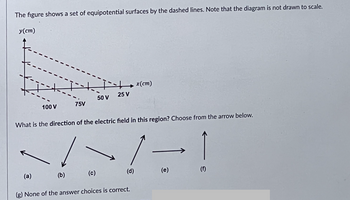
College Physics
11th Edition
ISBN: 9781305952300
Author: Raymond A. Serway, Chris Vuille
Publisher: Cengage Learning
expand_more
expand_more
format_list_bulleted
Concept explainers
Question

Transcribed Image Text:The figure shows a set of equipotential surfaces by the dashed lines. Note that the diagram is not drawn to scale.
y(cm)
FI
100 V
75V
(b)
50 V
(c)
25 V
What is the direction of the electric field in this region? Choose from the arrow below.
(d)
x(cm)
(g) None of the answer choices is correct.
(e)
(1)
Expert Solution
This question has been solved!
Explore an expertly crafted, step-by-step solution for a thorough understanding of key concepts.
Step by stepSolved in 3 steps

Knowledge Booster
Learn more about
Need a deep-dive on the concept behind this application? Look no further. Learn more about this topic, physics and related others by exploring similar questions and additional content below.Similar questions
- An electron passes through an area of changing potential as shown below. At point A, the electron has a speed of 7.2 × 106 m/s. What is the approximate speed of the electron at point B? A +10 V 7 +20 V B +30 Varrow_forwardDetermine the equivalent capacitance between A and B for the group of capacitors in the drawing. 5.0 µF 24 µF Number i Units 4.0 µF 12μF B▾ 6.0 µF 8.0 µFarrow_forwardFirst box choices are 4, 3, 6, 1, 2 (V) the second box choices are 1, 8, 3, 1.5, 6 (nJ) and the third box pick from I-Varrow_forward
- Suppose in the figure(Figure 1) that C1=C2=C3=40.9μFC1=C2=C3=40.9μF and C4=71.2μFC4=71.2μF. a.If the charge on C2C2 is Q2=20.7μCQ2=20.7μC, determine the charge on each of the other capacitors. Enter your answers numerically separated by commas. Determine the voltage across each capacitor. Enter your answers numerically separated by commas. Determine the voltage Vabacross the entire combination.arrow_forwardIn the figure below, equipotential lines are shown at 1-m intervals. Suppose that V₁ = 7 V₁ V₂ = 14 V, V3 = 21 V, V4 = 28 V, and V5 = 35 V. OV V₁ V₂ A V3 I Submit B V₁ 0 m 1 m 2m 3m 4 m 5 m Submit V₂ 1) What is the electric field at point A? Enter a positive value if the electric field points in the +x direction and a negative value if if the electric field points in the -x direction. (Express your answer to two significant figures.) V/m 2) What is the electric field at point B? Enter a positive value if the electric field points in the +x direction and a negative value if if the electric field points in the -x direction. (Express your answer to two significant figures.) V/marrow_forwardDetermine the equivalent capacitance between points a and b for the group of capacitors connected as shown in the figure. Use the values C1 = 5uF, C2 = 10uF, C3 = 2uE. If a potential difference of 50 V is established between terminals a and b, what will be the charge on the capacitors near terminal b? Determinar la capacidad equivalente entre los puntos a y b para el grupo de capacitores conectados como se muestra en la figura. Utilice los valores C1 = 5 µF, C2 = 10 µF y Ca = 2 µF. Si entre los extremos a y b se establece un a diferencia de potencial de 50 V, ¿Cuál será la carga en los capacitores %3D cercanos a la terminal b?. C2arrow_forward
- Note: The value of a=0, b=5 and C=7.arrow_forwardpotential begins to increase again, with each successive line 10 V higher until the 50 V Iline is of the top line is 30 V and the potential decreases by 10 V until the 0 V line is reached. Then, the The next three questions refer to the series of equipotential lines below. The electrical potential reached. Five positions, A -E are shown. +30 V +20 V В +10 V O V +30 V +50 V U. ....- 9. At which position is the magnitude of the electric field largest? d. D e. E а. А b. Вarrow_forward
arrow_back_ios
arrow_forward_ios
Recommended textbooks for you
 College PhysicsPhysicsISBN:9781305952300Author:Raymond A. Serway, Chris VuillePublisher:Cengage Learning
College PhysicsPhysicsISBN:9781305952300Author:Raymond A. Serway, Chris VuillePublisher:Cengage Learning University Physics (14th Edition)PhysicsISBN:9780133969290Author:Hugh D. Young, Roger A. FreedmanPublisher:PEARSON
University Physics (14th Edition)PhysicsISBN:9780133969290Author:Hugh D. Young, Roger A. FreedmanPublisher:PEARSON Introduction To Quantum MechanicsPhysicsISBN:9781107189638Author:Griffiths, David J., Schroeter, Darrell F.Publisher:Cambridge University Press
Introduction To Quantum MechanicsPhysicsISBN:9781107189638Author:Griffiths, David J., Schroeter, Darrell F.Publisher:Cambridge University Press Physics for Scientists and EngineersPhysicsISBN:9781337553278Author:Raymond A. Serway, John W. JewettPublisher:Cengage Learning
Physics for Scientists and EngineersPhysicsISBN:9781337553278Author:Raymond A. Serway, John W. JewettPublisher:Cengage Learning Lecture- Tutorials for Introductory AstronomyPhysicsISBN:9780321820464Author:Edward E. Prather, Tim P. Slater, Jeff P. Adams, Gina BrissendenPublisher:Addison-Wesley
Lecture- Tutorials for Introductory AstronomyPhysicsISBN:9780321820464Author:Edward E. Prather, Tim P. Slater, Jeff P. Adams, Gina BrissendenPublisher:Addison-Wesley College Physics: A Strategic Approach (4th Editio...PhysicsISBN:9780134609034Author:Randall D. Knight (Professor Emeritus), Brian Jones, Stuart FieldPublisher:PEARSON
College Physics: A Strategic Approach (4th Editio...PhysicsISBN:9780134609034Author:Randall D. Knight (Professor Emeritus), Brian Jones, Stuart FieldPublisher:PEARSON

College Physics
Physics
ISBN:9781305952300
Author:Raymond A. Serway, Chris Vuille
Publisher:Cengage Learning

University Physics (14th Edition)
Physics
ISBN:9780133969290
Author:Hugh D. Young, Roger A. Freedman
Publisher:PEARSON

Introduction To Quantum Mechanics
Physics
ISBN:9781107189638
Author:Griffiths, David J., Schroeter, Darrell F.
Publisher:Cambridge University Press

Physics for Scientists and Engineers
Physics
ISBN:9781337553278
Author:Raymond A. Serway, John W. Jewett
Publisher:Cengage Learning

Lecture- Tutorials for Introductory Astronomy
Physics
ISBN:9780321820464
Author:Edward E. Prather, Tim P. Slater, Jeff P. Adams, Gina Brissenden
Publisher:Addison-Wesley

College Physics: A Strategic Approach (4th Editio...
Physics
ISBN:9780134609034
Author:Randall D. Knight (Professor Emeritus), Brian Jones, Stuart Field
Publisher:PEARSON